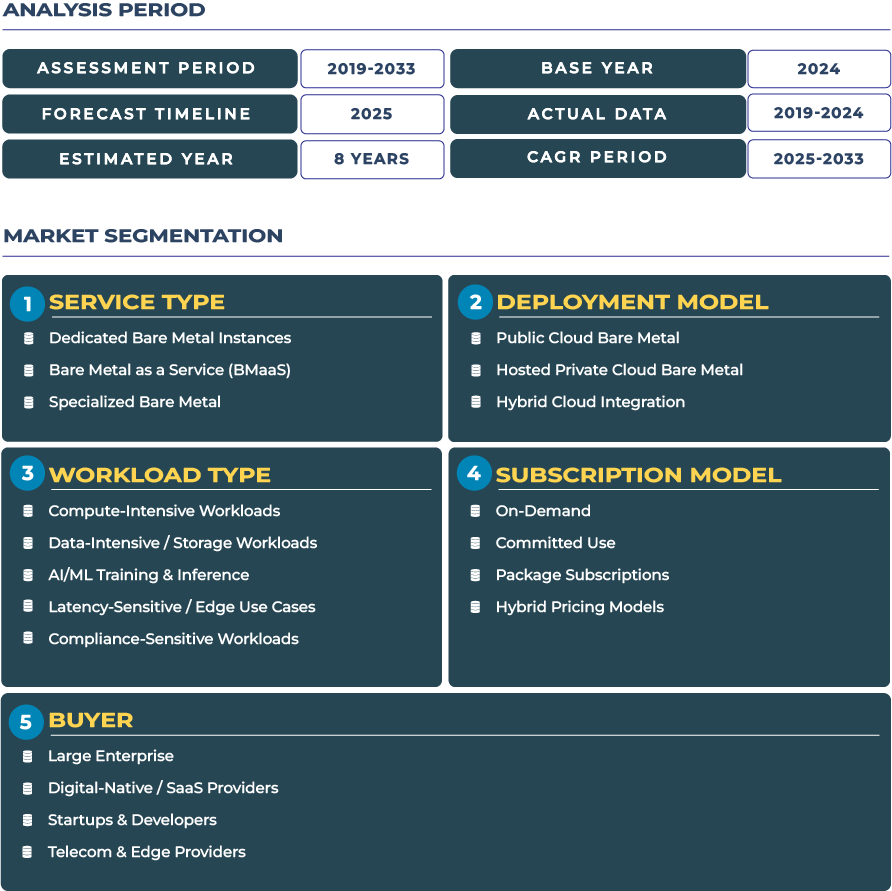Report Format:
![]()
![]() |
Pages: 110+
|
Pages: 110+
US Cloud Bare Metal Market Outlook: Hybrid Cloud & AI-Driven Bare Metal Solutions Fueling Growth
Accelerating Drivers: AI Model Training, Compliance Needs, and Enterprise-Grade Hybrid Integration
The U.S. cloud bare metal industry is expanding due to its alignment with enterprise priorities in AI, compliance, and hybrid IT strategies. One of the most significant drivers is the rising demand for AI and machine learning model training. Generative AI platforms and inference engines require dedicated, low-latency, high-performance servers, which are better delivered through specialized bare metal infrastructure. Additionally, enterprises are increasingly adopting bare metal as a service (BMaaS) to maintain agility while scaling model training workloads. Regulatory factors also play a role. U.S. industries such as healthcare and government prioritize data sovereignty, with compliance requirements under HIPAA and other federal frameworks accelerating the adoption of controlled, single-tenant bare metal deployments. Hybrid integration further strengthens adoption, as enterprises use bare metal for sensitive workloads while relying on cloud-based scalability for less critical processes. Collectively, these factors illustrate why enterprises are embedding bare metal at the heart of next-generation IT strategies.
Restraining Factors: Rising Power Demands and Complex Billing Models Challenge Adoption
While the US cloud bare metal ecosystem is positioned for growth, challenges remain in scaling adoption. A key restraint is the rising power and cooling requirements of dense HPC and GenAI-focused bare metal servers. As enterprises expand GPU-intensive clusters for AI/ML training, power costs escalate significantly, placing financial and sustainability strain on IT budgets. Additionally, complex billing models associated with hybrid bare metal deployments hinder transparency and predictability for enterprises. Integrating bare metal into hybrid cloud frameworks often requires dynamic pricing that includes compute, storage, network bandwidth, and data transfer charges, creating administrative complexity. Another issue is the shortage of highly specialized IT professionals who can manage hybrid bare metal at scale. These challenges necessitate innovation in energy-efficient infrastructure, simplified pricing mechanisms, and advanced automation tools for monitoring and orchestration in order to unlock the full potential of the cloud bare metal landscape in the U.S.
Shaping the Future: GenAI Training, AIOps Integration, and Blockchain/Web3 Opportunities
Several transformative trends are shaping the US cloud bare metal sector. The emergence of bare metal for generative AI training and inference is becoming a major catalyst, as enterprises demand performance isolation and dedicated GPUs for complex LLM workloads. In parallel, the integration of observability platforms and AIOps into bare metal management is gaining traction, allowing enterprises to optimize hybrid deployments while ensuring predictive maintenance and cost efficiency. From an opportunity perspective, financial trading firms in New York and Chicago are driving demand for specialized bare metal instances that deliver ultra-low latency and compliance alignment. Similarly, blockchain and Web3 platforms are increasingly turning to bare metal as a service for decentralized workloads, leveraging dedicated environments to support trust, scalability, and resilience. These trends highlight how the U.S. market is positioning itself as both an innovator and an enabler of new digital business models through specialized bare metal ecosystems.
Competitive Landscape: US Providers Accelerating Hybrid Cloud Connectors and AI Workload Optimization
The competitive dynamics of the US cloud bare metal market are defined by both global hyperscalers and specialized local providers. Companies such as IBM, Equinix Metal, and Oracle Cloud Infrastructure have expanded their offerings with hybrid bare metal connectors that integrate seamlessly with enterprise databases and compliance-heavy workloads. In 2023–2024, a leading U.S. cloud vendor expanded hybrid integration capabilities for enterprises running financial applications, enabling seamless scaling between private infrastructure and public bare metal instances. Another major development has been the optimization of bare metal environments for AI-driven workloads, with providers integrating GPU accelerators to meet the exponential demand from AI developers and enterprises. Sustainability is also shaping competitive strategies, with vendors investing in green data centers powered by renewable energy. This combination of hybrid innovation, AI-driven specialization, and sustainability initiatives underscores the maturity and future-readiness of the cloud bare metal industry in the United States.







